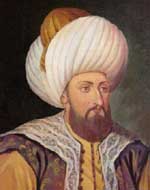
John Anagnostes
Encyclopedia
John, called Anagnostes was a Greek
historian of the fifteenth century. He was an eyewitness to the Ottoman
sack of Thessalonica
on March 29, 1430; an event he described in detail in his "Account of the Last Capture of Thessalonica" (), which he wrote with an accompanying monodia
lamenting the city's fall.
in 1402. The Byzantines
, unable to further defend the city, sold it to the Republic of Venice
in 1423; though not in time to mount a defense against another Ottoman siege that year. The Ottomans were again unable to hold the city permanently, and the Venetians and Ottomans were soon in a full state of war.
 Beginning on March 29, 1430, the Ottoman sultan Murad II
Beginning on March 29, 1430, the Ottoman sultan Murad II
began a three-day siege of Thessalonica, resulting in the conquest of the city by the Ottoman army, and the taking of 7,000 inhabitants as slaves. The Venetians agreed to a peace treaty and withdrew from the region in 1432, leaving the Ottoman's with permanent dominion over the region.
Greeks
The Greeks, also known as the Hellenes , are a nation and ethnic group native to Greece, Cyprus and neighboring regions. They also form a significant diaspora, with Greek communities established around the world....
historian of the fifteenth century. He was an eyewitness to the Ottoman
Ottoman Empire
The Ottoman EmpireIt was usually referred to as the "Ottoman Empire", the "Turkish Empire", the "Ottoman Caliphate" or more commonly "Turkey" by its contemporaries...
sack of Thessalonica
Thessaloniki
Thessaloniki , historically also known as Thessalonica, Salonika or Salonica, is the second-largest city in Greece and the capital of the region of Central Macedonia as well as the capital of the Decentralized Administration of Macedonia and Thrace...
on March 29, 1430; an event he described in detail in his "Account of the Last Capture of Thessalonica" (), which he wrote with an accompanying monodia
Monodia
Monodia can refer to:* the Mauritanian gerbil, sometimes placed in a genus Monodia.* Monodia , a genus of grasses in the Chloridoideae subfamily.* monody, a musical composition with a single melodic line or voice...
lamenting the city's fall.
Background
Thessalonica had been captured by the Ottomans in 1387; though they were unable to hold the city in the wake of the Battle of AnkaraBattle of Ankara
The Battle of Ankara or Battle of Angora, fought on July 20, 1402, took place at the field of Çubuk between the forces of the Ottoman sultan Bayezid I and the Turko-Mongol forces of Timur, ruler of the Timurid Empire. The battle was a major victory for Timur, and it led to a period of crisis for...
in 1402. The Byzantines
Byzantine Empire
The Byzantine Empire was the Eastern Roman Empire during the periods of Late Antiquity and the Middle Ages, centred on the capital of Constantinople. Known simply as the Roman Empire or Romania to its inhabitants and neighbours, the Empire was the direct continuation of the Ancient Roman State...
, unable to further defend the city, sold it to the Republic of Venice
Republic of Venice
The Republic of Venice or Venetian Republic was a state originating from the city of Venice in Northeastern Italy. It existed for over a millennium, from the late 7th century until 1797. It was formally known as the Most Serene Republic of Venice and is often referred to as La Serenissima, in...
in 1423; though not in time to mount a defense against another Ottoman siege that year. The Ottomans were again unable to hold the city permanently, and the Venetians and Ottomans were soon in a full state of war.
Siege of Thessalonica

Murad II
Murad II Kodja was the Sultan of the Ottoman Empire from 1421 to 1451 ....
began a three-day siege of Thessalonica, resulting in the conquest of the city by the Ottoman army, and the taking of 7,000 inhabitants as slaves. The Venetians agreed to a peace treaty and withdrew from the region in 1432, leaving the Ottoman's with permanent dominion over the region.

